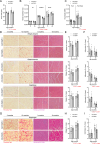Type-2 innate signals are dispensable for skeletal muscle regeneration and pathology linked to Duchenne muscular dystrophy
- PMID: 39900735
- PMCID: PMC11894123
- DOI: 10.1038/s44319-025-00383-y
Type-2 innate signals are dispensable for skeletal muscle regeneration and pathology linked to Duchenne muscular dystrophy
Abstract
Immune responses play an integral role in skeletal muscle regeneration. In the genetically inherited muscle disease Duchenne muscular dystrophy (DMD), muscle regeneration is disrupted, leading to chronic inflammation, fibrosis, and early mortality. Previously, it has been suggested that type-2 innate immune cells, particularly eosinophils and their production of IL-4, play an essential role in effective muscle regeneration after acute injury. We here re-investigate the role of eosinophils in skeletal muscle repair using mice deficient in eosinophils (ΔdblGATA), or deficient in IL-4R/IL-13R signaling through STAT6 (Stat6-/-). We show that neither deficiency has an impact on skeletal muscle regeneration in response to acute injury as quantified by fiber size, immune cell infiltration, or muscle-resident stem cell proliferation. We also investigate the role of STAT6 signaling in mdx:Stat6-/- mice, a model of DMD and, again, find that ablation of STAT6 signaling has no effect on the rate or severity of fibrotic scar formation or disease progression. In contrast to previous models, our data suggest a negligible role for eosinophils and STAT6 signaling in skeletal muscle regeneration after acute or chronic injury.
Keywords: Duchenne Muscular Dystrophy (DMD); Eosinophils; STAT6 Signaling; Skeletal Muscle Regeneration.
© 2025. The Author(s).
Conflict of interest statement
Disclosure and competing interests statement. The authors declare no competing interests.
Figures









References
-
- Annunziato F, Romagnani C, Romagnani S (2015) The 3 major types of innate and adaptive cell-mediated effector immunity. J Allergy Clin Immunol 135:626–635 - PubMed
-
- Babaeijandaghi F, Cheng R, Kajabadi N, Soliman H, Chang CK, Smandych J, Tung LW, Long R, Ghassemi A, Rossi FM (2022) Metabolic reprogramming of skeletal muscle by resident macrophages points to CSF1R inhibitors as muscular dystrophy therapeutics. Sci Transl Med 14:eabg7504 - PubMed
MeSH terms
Substances
Grants and funding
LinkOut - more resources
Full Text Sources
Molecular Biology Databases
Research Materials
Miscellaneous

